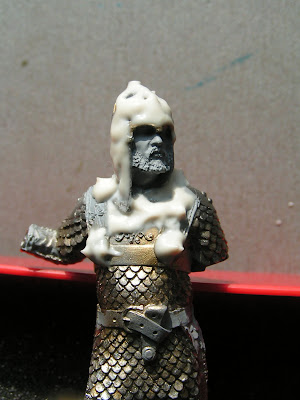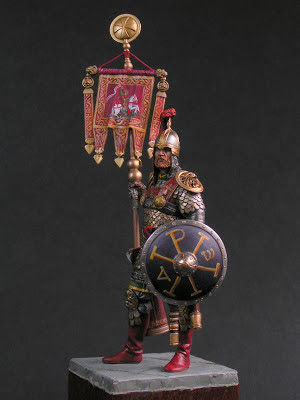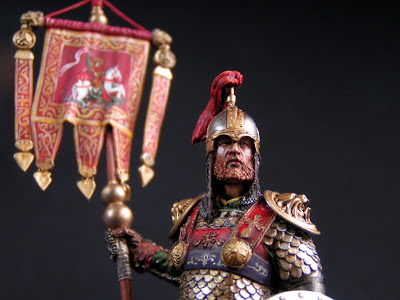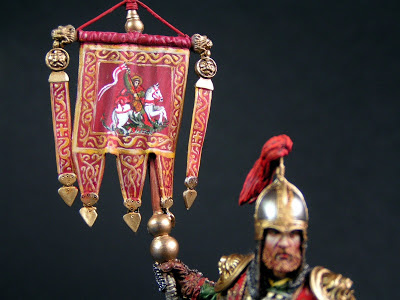The varengian guards were an elite group recruited from the norseman rows. Some has arriwed in the region via the Baltic Sea, crossing the plains from Novgorod thru the actual teritories of Poland and Ucraine, to the Black Sea, in their "harvesting" incursions. Other leaved the scandinavian shores to get to the British islands and sailing even all the way to the Iberic peninsula, occupied then in a vast majority by the saracens.
No one knows exactly why they started their incursions in the firs place. Reading their sagas one could understand that they didn’t seek to extend any empire nor they are only looking to lute some helpless foreign farmers. On the other hand they were a strong nation used with the harsh facts of life in a sparse environement.
The figure I choosed to paint is made by the renowned Pegasso Models in 75 mm scale and as a coincidence comes to my hands just after the (90 mm) Viking warrior from the same producer.
After reading the impressive (at least for me) saga writen by Olaf Bergstorm "The Vikings", I pictured in my mind the different looks of Orm Tosteson, the main character, along his journey around Europe.
Unfortunately I wasn't able to finish the Viking first, so the history is somehow reversed here.
Nevertheless I started working at the Bizantine standard bearer in the spring of 2012. It was a pleasure to work at it, thanks to the very mindfull way in which the whole ansamble has been splited for casting.
It practicaly needed no putty and the joints are thought in a way so that they permit slight posture corrections while glueing it.
Despite my habbit of creating a very complex base, this time, bearing in mind that the figure will be highly decorated not only with painted details but also with a welth of relief models, I opted to leave the kit base as simple as possible. I only had to make minor adjustments to enhance the dimensions of the metal base to be the same as the surface of the wooden postament.
After the base was glued with two part epoxi and secured by 3 metal pins, I completed the surface with plumber two part putty, and sculpted it to continue the orriginal model of tile stones.
As usual for me I opted to mantain the natural metal where it was needed. For this I polished the metal surfaces with a roto-tool armed with a brass round bristle. Some parts that I intended to be more shiny was then touched individualy with a blunt spatula, leveling all the microscopic scratches. This was the case for the scales of the boddy armor and the helmet. Furthermore I tinted or aplied Agama metal paste to some areas to represent different kinds of metal. You can see in the image below trials i've made on a coin with different tones of gold and brass.
Then, all the metal surfaces was protected with liquid masking fluid and the remaining parts sprayed with my usual gray primmer. I then removed the masking agent to inspect the demarcation between metalic tones and primed surfaces.
After this operation, I masked around the face in preparation for the aplication of the skin tone.
This was done from Valejo acrilics - Medium flesh, English uniform and a few drops of burnt sienna. The last was added to obtain a redish tanned kind of skin bearing in mind the effects of the mediteranean sun on a man from the nord. The paint was aplied with an airbrush, for an even coating and preservation of most of the details. The redish taned effect is not so evident but is there and I am happy with it.
After driyng for a few hours, the mask was removed.
The figure was now ready to receive the rest of the paint, so I stick a pin up his ... that was then introduced with the other end in a mechanical pencil, for ease of handling.
Before starting to aply paint I applied some washes to the metal parts to unify the surface effect and also to confere an weathered aspect to the metal parts. Some scales of the boddy armor received 2 or 3 layers of wash. I wanted to avoid a monotonous surface.
An important step in painting the face of this figure was to choose a propper color for the beard. I saw many figures of vikings with blond hair. Even one of my previous figure falls in this clichee. So for this time I opted for a reddish tone.
A few minutes of documentation on google images brought me this image of a young bearded scandinavian.
Observing nature is almost useful. I belive our "mission" when painting figures is not to aply certain techniques as a rule, nor to copy others figures painted by renowned painters, but to try to replicate what we see in nature.
So, a middle tone of reddish Still de Grain oil color was painted in. This color is translucent, giving the advantage that in creases will be darker while on the top of the relief details, the paint being thinner will show the underneath color of the skin.
After drying this was still enhanced by sienna shadows and yellow ochre lights as you will see in the next pictures.
The stage was set for the colors of the garments.
While bizantine dress was flamboyant and colorfull, I learned studying bizantine icons that colors were deep and rich. Combination of dark red with deep green, embroided with gold thread is more often represented in the garments of military figures. To have an ideea about what I am talking about, I will post here a couple of images from the bizantine iconography.
Those paintings are not from that age but you must know that bizantine painting are following certain rules that have been structured in books called "Erminii". So there are very strict rules in depicting different personages, rules that has been stated by the Orthodox Sinods. This rules have been followed throughout the whole sphere of influence of the Orthodox Church, many similarities being found in the religious painting from Russia, Serbia, Muntenegro, Romania, Bulgaria and others.
The colors on the boxart, showing the work of the renowned painter Pietro Baloni, looked to me too bright. So after planing the setting of colors I get to this combination.
After the base colors for the garments was put in place I wanted to finish most of the face, to be free to deal with the rest of the figure.
From this point on, things worked as in the most of the cases. The colors being painted in their places it was more as keeping a balance between asembling and painting. Modulation of the base tones was made with oil colors.
Faithfull to my habbit I avoided to modulate in too many tones the base tones because the subject is already tridimensional and any aoverdoing of this modulation will restraint the way the subject might be admired.
The Flag.
I strated my documentation without too much hope. Just wanting to find something suitable, which has a historic corespondent. But I found a long article with diagrams regarding the subject of signs and flags in the bizantine empire. It turn out that one of the varengian guard flag bared the image of Saint George on horse killing the Ddragon. In the article the image was just sketched in one color. Inspired by Pietro Baloni, a master of filigran work in color, I set as a goal to depict Saint Georges image in detail, benefiting by my icon painter formation.
On the back of the flag ( named "prapur") I chose to represent the bicephal eagle, simbol of the Imperial Orthodox Church, to sugest an embroiding procedure.
On the shield I chose to paint the Hristic monogram (XP - which in greek alphabet is read HR from Hristos) and on sides the letters Alpha and Omega which remeber the words of God transmited to people by Jesus - "I am alpha and omega the first and the last, the beginning and the end..." Meaning that every thing on this world is starting and ending with God and by His will.
Some observations:
The cord of the bow was made from an elastic thread that dosen't tense the white metal bow.
For the color of the flag pole I chose a darker color, to represent the fact that the wood was old but not painted or tinted.
The ornament of the boots. I noticed there was some chain rings at the superior part which linked those ornaments from the boot. So I considered them as made by metal.
I skiped the feathers or horsehair that came out of the lions mouths on the sholders. I considered this too much and I feel like those ornaments were breaking the elegance of the silouhete making it to science-fiction. Maybe there was ornaments like those in that time but the metal representation laked the fluidity of the real things.
Please feel free to coment here.
Thank you for watching.























Niciun comentariu:
Trimiteți un comentariu